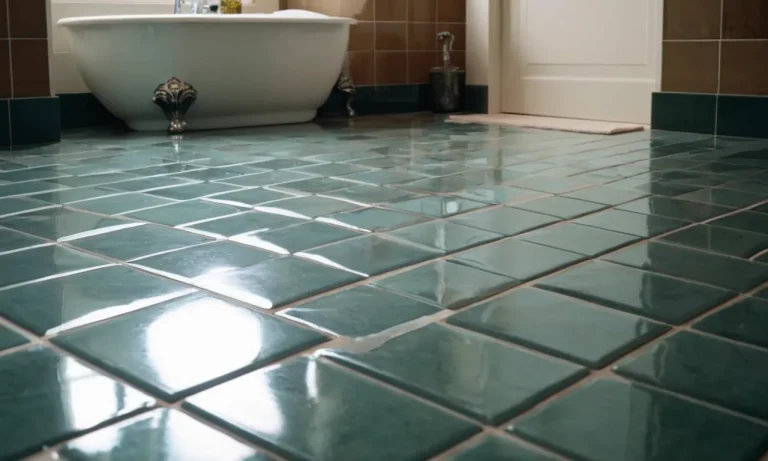Can Exterior Paint Be Used Inside? A Detailed Guide
Painting the interior walls of your home can be an expensive endeavor. With rising prices, many homeowners wonder if they can save money by using leftover exterior paint indoors. This comprehensive guide will examine if you can use exterior paint inside your house and provide key factors to consider before deciding.
Can You Use Exterior Paint Inside?
Many people wonder if it’s possible to use exterior paint inside their homes. While it may seem like a convenient option, there are several factors to consider before making this decision. Let’s explore the differences between exterior and interior paints and the potential risks associated with using exterior paint indoors.
Exterior paints are formulated differently than interior paints
Exterior paints are specifically designed to withstand harsh weather conditions, such as rain, snow, and UV rays. They are formulated with additives and resins that provide extra durability and protection against the elements.
On the other hand, interior paints are created with a focus on aesthetics, ease of application, and low levels of volatile organic compounds (VOCs) to ensure the health and safety of indoor spaces.
One of the key differences between exterior and interior paints is the level of VOCs. Exterior paints typically contain higher levels of VOCs, which can emit harmful fumes when used indoors. These fumes can lead to respiratory issues, headaches, and other health problems, especially for individuals with allergies or sensitivities.
Additionally, exterior paints may have a stronger odor compared to interior paints. The odor can linger for an extended period, making it unpleasant to be in the room. Interior paints, on the other hand, are formulated to have low odor and quick drying times, allowing for a more comfortable and convenient painting experience.
Using exterior paint inside comes with some risks
While it may be tempting to use exterior paint indoors, it is important to consider the potential risks involved. The higher levels of VOCs in exterior paints can contribute to poor indoor air quality, which can have detrimental effects on your health and well-being.
In addition to the health risks, using exterior paint inside may also result in poor adhesion, uneven drying, and a less durable finish.
Furthermore, using exterior paint indoors may void any warranties or guarantees provided by the manufacturer. Exterior paints are not tested or approved for interior use, so any issues that arise from using them indoors may not be covered by the manufacturer.
Factors to Consider Before Using Exterior Paint Indoors
Before deciding to use exterior paint indoors, there are several important factors that should be taken into consideration. These factors can help determine whether or not exterior paint is suitable for indoor use, and can ensure that you achieve the best results possible.
Finish and sheen
One of the main factors to consider is the finish and sheen of the exterior paint. Exterior paints are typically formulated to withstand harsh outdoor conditions, so they often have a more durable and glossy finish.
This may not be ideal for indoor use, as it can create a shiny and reflective surface that may not be visually appealing.
Hiding ability
Another factor to consider is the hiding ability of the exterior paint. Exterior paints are designed to cover imperfections and provide a uniform appearance on a variety of surfaces. However, the high hiding ability of exterior paint may not be necessary for indoor use, where the surfaces are typically smoother and have fewer imperfections.
VOC content
Volatile Organic Compounds (VOCs) are chemicals that are released into the air as paint dries. These chemicals can have harmful effects on indoor air quality and human health. Exterior paints often contain higher levels of VOCs compared to interior paints due to the need for greater durability and weather resistance.
It is important to consider the VOC content of the paint before using exterior paint indoors, as it may exceed the recommended limits for indoor use.
Mildew resistance
Exterior paints are formulated to resist mildew growth, as they are exposed to moisture and humidity. While mildew resistance is important for exterior surfaces, it may not be as crucial for indoor use, especially in dry and well-ventilated areas.
Using exterior paint indoors may not provide any additional benefits in terms of mildew resistance, and may even contain additional chemicals that are not suitable for indoor environments.
Colorfastness
Exterior paints are specifically designed to withstand UV rays and harsh weather conditions, which can cause colors to fade over time. While colorfastness is important for exterior applications, it may not be as critical for indoor use, where the paint is protected from direct sunlight and extreme weather.
Using exterior paint indoors may not provide any significant advantage in terms of color retention.
Odor
Exterior paints often have a stronger odor compared to interior paints, due to the higher levels of VOCs. This can be a major concern when using exterior paint indoors, as the strong smell can linger for longer periods of time and may be unpleasant for occupants.
It is important to consider the odor of the paint and its potential impact on indoor air quality before using exterior paint indoors.
Considering these factors can help you make an informed decision about whether or not to use exterior paint indoors. It is always recommended to use paint that is specifically formulated for interior use, as it is designed to meet the specific requirements and conditions of indoor environments.
If you have any doubts or questions, it is best to consult with a professional painter or paint supplier for guidance.
Pros of Using Exterior Paint Inside
While it is generally not recommended to use exterior paint inside, there are a few potential advantages to consider. Here are some pros of using exterior paint indoors:
1. Durability:
Exterior paint is specifically formulated to withstand harsh weather conditions, such as extreme temperatures, UV rays, and moisture. This makes it more durable than interior paint when it comes to resisting wear and tear.
If you have a high-traffic area in your home, such as a hallway or children’s playroom, using exterior paint can help ensure that the walls stay looking fresh for longer.
2. Mildew and Mold Resistance:
Exterior paint is often designed to have properties that inhibit the growth of mildew and mold. This can be beneficial in areas of your home that are prone to moisture, such as bathrooms or basements. By using exterior paint indoors, you can add an extra layer of protection against these common issues.
3. Fade Resistance:
Exterior paint is typically made with pigments that are more resistant to fading caused by sunlight. If you have a room with large windows or a lot of natural light, using exterior paint can help maintain the vibrancy of the colors over time.
4. Greater Color Selection:
Exterior paint often comes in a wider range of colors than interior paint. This can be advantageous if you have a specific color scheme in mind for your indoor space and are unable to find a suitable match in interior paint options.
5. Increased Protection:
Exterior paint is usually formulated to provide an extra layer of protection to the surfaces it coats. This can be beneficial in areas that are exposed to heavy use or potential damage, such as kitchens or laundry rooms.
The added protection can help prevent scratches, stains, and other forms of damage.
It’s important to note that while there may be some benefits to using exterior paint indoors, there are also potential drawbacks and risks. Exterior paint may contain higher levels of volatile organic compounds (VOCs) than interior paint, which can contribute to indoor air pollution and may be harmful to your health.
Additionally, exterior paint may have a different texture and finish than interior paint, which could result in an undesirable aesthetic outcome.
Before deciding to use exterior paint inside, it’s best to consult with a professional painter or paint supplier who can provide guidance based on your specific needs and concerns. They can help you choose the most suitable paint for your project and ensure that it meets the necessary safety and quality standards.
Cons of Using Exterior Paint Inside
While it may be tempting to use exterior paint indoors, there are several drawbacks to consider. Here are some of the main cons of using exterior paint inside:
1. Strong Odor:
Exterior paints often contain higher levels of volatile organic compounds (VOCs) compared to interior paints. These VOCs can release strong odors that linger in enclosed spaces, such as bedrooms or living rooms. Breathing in these fumes for prolonged periods can be harmful to your health.
2. Poor Indoor Air Quality:
The high VOC content in exterior paint can also contribute to poor indoor air quality. VOCs can off-gas for weeks or even months after application, leading to respiratory issues, headaches, and dizziness. This is particularly concerning for individuals with asthma or other respiratory conditions.
3. Difficulty in Application:
Exterior paints are formulated to withstand harsh weather conditions, such as UV rays, moisture, and temperature fluctuations. As a result, they have a thicker consistency and may be more challenging to apply smoothly on indoor surfaces. This can lead to uneven coverage and an unprofessional finish.
4. Longer Drying Time:
Exterior paints are designed to dry more slowly in order to allow for better adhesion and durability. If used indoors, this slower drying time can be frustrating and inconvenient, especially if you need to use the room soon after painting.
It can also increase the chances of accidental smudging or damage to the freshly painted surface.
5. Lack of Variety:
Exterior paint colors are typically limited in range compared to interior paints. While exterior paint may offer a wide selection of earth tones and neutral shades, it may not have the vibrant or unique colors you desire for your indoor space.
Interior paints are specifically formulated to provide a broader range of colors and finishes.
6. Potential for Mold Growth:
Exterior paints often include additives to resist mold and mildew growth. However, these additives may not be suitable or necessary for indoor use. Using exterior paint indoors, especially in areas prone to high humidity such as bathrooms or basements, can create an environment that promotes mold growth.
It’s essential to prioritize the health and safety of your indoor environment. Therefore, it is generally recommended to use interior paint for interior spaces. However, if you are considering using exterior paint inside, make sure to research the specific product and consult with a professional for guidance.
Best Practices for Using Exterior Paint Indoors
Test on a small area first
Before diving into painting your entire interior with exterior paint, it is crucial to test it on a small, inconspicuous area first. This will help you determine how the paint adheres to the surface and how it looks in terms of color and texture.
Keep in mind that exterior paints are designed to withstand harsh weather conditions, so they might have a different finish and durability compared to interior paints.
It is always better to be safe than sorry, so take the time to test the paint on a small area and observe the results before proceeding with the entire project. This will save you from any potential headaches and disappointments down the line.
Prepare the surface properly
Proper surface preparation is key to achieving a smooth and long-lasting paint finish, whether you’re using exterior or interior paint. Make sure to clean the surface thoroughly, removing any dirt, dust, or grease.
Scrape off any loose paint or flaking areas and sand the surface to create a smooth and even base for the paint.
Additionally, repairing any cracks or holes in the surface is essential to ensure a flawless end result. Fill in any imperfections with spackle or putty, and sand them down until they are flush with the surrounding surface.
By taking the time to properly prepare the surface, you’ll ensure that the paint adheres well and looks great.
Apply primer
Using a primer is highly recommended when using exterior paint indoors. Primers not only provide better adhesion for the paint, but they also help to seal the surface and prevent any stains or discoloration from bleeding through the paint.
There are different types of primers available, so make sure to choose one that is suitable for your specific surface and paint type. Apply the primer evenly and allow it to dry completely before moving on to the actual paint application.
Opt for low-sheen finishes
When using exterior paint indoors, it is advisable to opt for low-sheen finishes. Exterior paints typically have a higher sheen level to withstand weathering and provide better protection to the surface.
However, these high-sheen finishes can be less desirable for interior spaces as they tend to show imperfections and can create a glare.
Choosing a low-sheen or satin finish will give your interior a more subtle and elegant look, while still providing the durability and easy maintenance associated with exterior paints.
Ventilate the room during and after painting
Painting can release fumes and odors that may be harmful if inhaled in large quantities. To ensure your safety and create a comfortable painting environment, it is important to ventilate the room properly.
Open windows and doors to allow fresh air to circulate, and consider using fans to further improve air circulation. Once you have finished painting, continue to ventilate the room for a few days to allow any remaining fumes to dissipate.
Remember, safety should always be a priority when undertaking any painting project.
Conclusion
While exterior paints are not formulated for indoor use, they can be an economical option in less-used areas of your home if applied correctly. Consider finish, hiding power, VOCs, and other factors before deciding. Test a patch first and follow best practices for surface prep and application.







